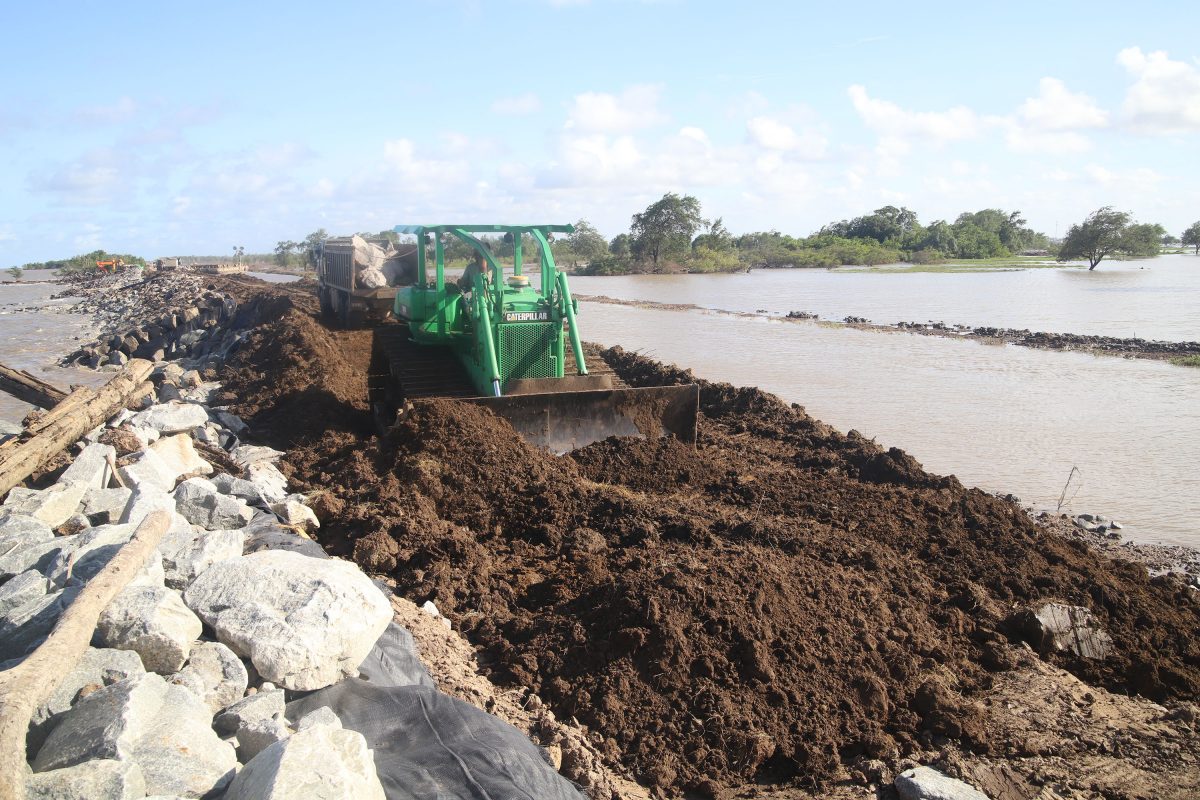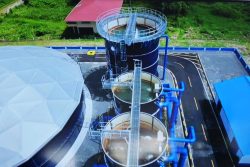Residents living between the vulnerable communities of Columbia and Fairfield, in Region Five, have voiced concerns over the earthen dam being constructed by the National Drainage and Irrigation Authority (NDIA) to ease flooding.
During a visit by this newspaper to the communities yesterday, residents said the dam being constructed inland is not being built to the specifications that were announced by head of the NDIA Fredrick Flatts just over a week ago.
According to the residents, the dam, which was supposed to prevent flooding from recurring in their communities, is only four feet high, which they say would not serve the intended purpose.
Flatts had told the Department of Public Information that a secondary dam would be built between Fairfield and Dantzig. “The secondary dam would be very high, about 8 feet high above the land and about 12 feet top width. It’s a significant dam. That dam will start at the sea defence to cross the Bellamy Canal coming about 800 feet into the land, then go parallel to the sea defence and come back in at Fairfield,” he was quoted as saying.
Residents pointed out that what is being built is not what was promised and that at the current height the dam would not prevent them from being flooded during the next high tide.
“The sea dam the contractors are building is about nine feet in height and water is still overtopping in some sections so imagine what would happen if another high tide comes. We will be flooded again,” resident of Fairfield Cleveland Ramsammy said.
Efforts to contact the NDIA head for a comment on the concerns shared by residents proved futile.
The residents of Mahai-cony became vulnerable as a result of the breaches in the sea defence along Dantzig to Fairfield. The three-kilometre stretch along the shoreline is currently being impacted by major erosion of the foreshore and depletion of the mangrove fringe.
Two separate spring tides have recently devastated the lives of residents of the area, leaving them to cope with unexpected damage as well as being flooded. Hundreds of acres of rice fields and animals were lost as a result of the flooding. Losses are said to be in the millions.
Ramsammy noted that the sea defence remains under threat as the force of the water is undermining the work of the contractors. It was related that during normal tides, the water would overtop onto the sea dam.
Additionally, Ramsammy believes that in order for the inland dam to work, it has to be constructed all the way to Cottage and not Fairfield. He explained that with a cut off at Fairfield, the water will still get into lands and even flood neighbouring communities.
Sea defence
“If the water is overtopping on the sea dam now when the tide is normal, it will definitely overtop at the next high tide and run across and cover the dam that they are building,” Ramsammy emphasised.
While the contractor at Fairfield has been able to complete a significant portion of the rip rap sea defence, it is being compromised as the water has been “pulling the rocks into the ocean. If you watch there you can see the rocks,” Ramsammy said, as he pointed to the boulders in the river.
During Sunday Stabroek’s visit to the community, truckloads of earth and boulders were being delivered and stocked on site as workers aimed to complete works in a timely manner.
The next major high tide is schedule for late November, according to the residents.
Some believe that government should have looked at the option of sheet piling to create a sea defence instead of rip rap.
“A sheet pile solution would have been better because this rip rap cannot seem to stand the force of the water. It is not suitable for here. The force of the water is too strong and it is resulting in erosion of the sea dam,” a resident explained.
At Dantzig, works are moving at a slower pace as the water remains treacherous and is preventing barges with boulders from safely landing. The
contractor, BK International, residents said, has not been able to stock up on materials like the other contractor, A & S General Contractors Inc, given the challenges at sea.
More flooding
The residents noted further that while the dam should aid in the prevention of flooding in their communities, residents between from De Hoop and further east Mahaica would end up being affected.
“While this dam would help us, the water would redirect itself to the other villages that way (east of Fairfield). And that would be a new situation they have to deal with,” Ramsammy added.
He posited that if authorities direct some attention to desilt the Cottage channel and put the Plantain Hall/ Cottage sluice into operation, they will be able to bring fast relief to residents. He stated that this is a possible solution to prevent other communities from being flooded as well.
Ramsammy, who sits a Councillor on the Neighbourhood Democratic Council of Woodlands/ Fairfield, told this publication that they have observed water from the backdams flowing into their drains, which is an indication that some farmers have opened up passageways to flush the salt water off their farmlands and out of drains.
He noted that given the excess water on the land, they are likely to become victims of more flooding. “With all this excess water that is already on the land and what is coming down from the backdam and the rains that are coming, we are likely to be flooded again,” he observed.
Water from the Atlantic is continuously flowing into and over the Bellamy canal and making its way onto land as a significant stretch of sea defence remains exposed to the ocean.
With this situation at hand, Ramsammy said he had suggested to authorities to look at the possibilities of installing two new culverts along the Cottage sideline dam and operating the sluice. “If they put in two new culverts and open the sluice at low tides, water on the land and the savannah can be drained off. We won’t be having so much water remaining on the land,” Ramsammy said.
He noted that the while he has made suggestions, no action has been taken.
“They are not coming and listening to our concerns but they are making decisions in their office. We are the residents here and we are the ones that know our drainage systems, so we are the ones to best advise them on what can be done but nobody is listening to us,” Ramsammy emphasised.
He also reiterated that government should begin considering relocation options should the effects of global warming become more severe.
He stated that several of villagers, including him, are willing to relocate at this moment to higher grounds along the Linden highway but they need government to start the consultation process.













